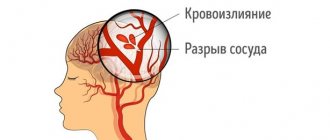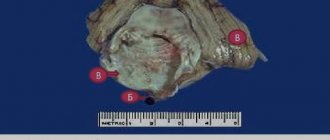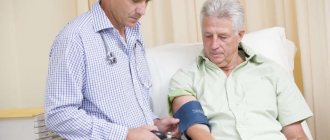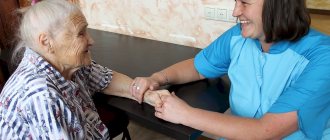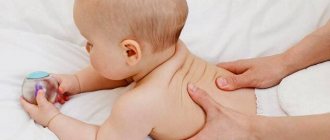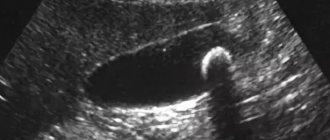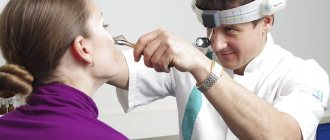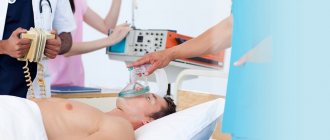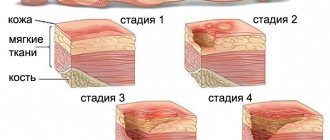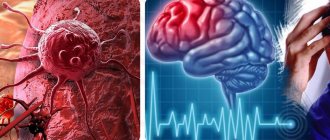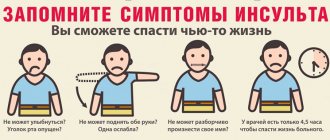Useful articles
Stroke is a rapidly developing dysfunction of the central nervous system, which can be caused by hemorrhage (hemorrhagic form) or spasm or blockage of cerebral vessels (ischemic type). Recovery from a stroke on the right side is a fairly long process. Patients are strongly recommended to undergo rehabilitation in specialized centers under the supervision of qualified doctors.
Causes of brain stroke on the right
{banner_banstat0}
A right-sided stroke is different from a left-sided cerebral blood flow disorder because the functions of the two hemispheres are different. In the right - the centers that are responsible for sensitivity, motor skills, coordination are localized; with the help of the right hemisphere, a person understands words, uses hearing, touch, intuition, evaluates the surrounding space, perceives music, reads, writes, recognizes geometric shapes. In addition, the entire left side of the body is monitored and the information is analyzed together with data from the left hemisphere to completely solve any problem.
During a stroke, any of the listed functions are disrupted, and the trigger can be either an endogenous or an exogenous factor. The most dangerous:
- alcoholism, smoking, drugs;
- blood pressure surges, high ICP;
- binge eating;
- obesity;
- atherosclerosis;
- increased blood clotting;
- stress, psycho-emotional and physical stress;
- brain injuries;
- congenital pathologies;
- chronic somatic diseases of the heart and blood vessels;
- uncontrolled use of contraceptives.
Children with heart defects, genetic blood diseases, and endocrine disorders are at particular risk for right-sided stroke.
What is ischemic and hemorrhagic stroke
{banner_banstat1}
According to etiology, right-sided stroke is divided into ischemic and hemorrhagic. The first develops due to impaired cerebral blood flow on the right due to narrowing of blood vessels or their complete blockage; the speed of blood movement and its viscosity also play a role. As a result, hypoxia of brain cells is provoked with their death and necrosis of a certain area of the brain. Symptoms of ischemic stroke increase gradually, so ischemia develops over several hours or even days, which makes it possible to consult a doctor in a timely manner and avoid fatal consequences. The prognosis for this form of the disease is affected only by the extent of the lesion (necrosis).
Hemorrhagic stroke is a hemorrhage in brain tissue due to rupture of blood vessels. Often this situation leads to cerebral edema, coma and death. Vascular rupture occurs much less frequently, but has more severe consequences, since there is no time to “build up”. The spilled blood permeates the tissues, compresses vital structures, sometimes completely destroying them. Regardless of the size of the affected area of the brain, nerve cells are restored slowly; not all lost functions of the nervous system can be restored.
Causes of development of right-sided stroke
The most common causes of the development of right-sided hemorrhagic strokes are atherosclerotic changes in the cerebral vessels of the right hemisphere, as well as a significant increase in blood pressure (in particular, against the background of hypertension). A sharp jump in blood pressure due to pathological changes in the vascular wall leads to rupture of the vessel. Right-sided ischemic stroke, as a rule, develops due to blockage of a vessel and disruption of the blood supply to a separate area of the brain.
Consequences of ischemia
{banner_banstat2}
With a small area of necrosis of brain tissue or a micro-stroke on the right, the prognosis for the patient’s life is favorable: neurological changes are minimal and do not criminally impair brain function. An exception is trunk ischemia, since vital centers - respiratory and cardiovascular - are concentrated here. Therefore, even a microstroke of the brain stem almost 100% ends in death in the first hours.
The remaining patients will experience disability because, although they are not completely bedridden, they lose even a small ability to adequately, fully perceive the surrounding reality, understand what is happening to them, and the ability to think logically. For left-handed people it’s the other way around. For them, the consequences of a right-sided stroke are similar to ischemia of the left hemisphere in right-handed people.
The main consequences are presented in the table. We must understand that the consequences of ischemic stroke decrease over time with proper treatment. About a quarter of patients under 55 years of age recover fully from a microstroke without visible signs of any neurological impairment.
At the same time, no matter how many functions are rehabilitated in the first two years after a micro-stroke, so many will remain until the end of days. Nerve cells are practically not restored.
| Outcome of stroke on the right | Consequences of micro and macro ischemic stroke |
| Complete paralysis of the left side of the body | The movements of the left limbs are minimized, the position is half-bent, the patient is able to sit, but without assistance he is not able to walk or grasp objects with his hand (hemiplegia) |
| Imbalance of sensitivity on the left | Pain and temperature threshold increases (hypoesthesia) |
| Loss of sense of spatial arrangement of arms and legs | |
| Mental disorders | Criticism decreases, foolish behavior arises, speech becomes inadequate, the person becomes aggressive |
| Memory loss | Patients remember the past, but forget what they did an hour ago; temporary complete amnesia and disorientation in space and time are possible |
| Left vision disorders | Decreased vision up to blindness, double vision, turning the head and left eye to the left |
If the area of brain necrosis is large (massive stroke), the prognosis is disappointing: up to 70% of patients die in the first few days, others become deeply disabled. The consequences are:
- persistent paralysis: patients cannot even sit;
- cerebral coma;
- complete lack of criticism and thinking;
- swallowing disorders.
Treatment and rehabilitation of patients
Important: Prompt hospitalization of the victim provides a favorable prognosis.
In case of right-sided stroke, recovery is possible in full with early diagnosis of the pathology, as well as timely initiation of adequate complex therapy. If the patient is delivered to the hospital on time and receives qualified assistance, the rehabilitation process proceeds faster and the consequences may be minimal. Paralysis in this case is relatively easy to correct. Speech defects with early treatment are less pronounced.
Medical tactics directly depend on the form of stroke. If ischemia occurs, the first priority is to maintain vital functions and simultaneously eliminate spasm or blockage of the right hemisphere vessel. In case of thrombosis, thrombolytic agents and drugs are necessarily administered to increase blood circulation in the cerebral hemispheres. The hemorrhagic variety requires prompt removal of hematomas and blood clots, as they put pressure on the brain tissue. After this, symptomatic treatment is carried out, aimed at quickly eliminating the consequences of hemorrhage.
Recovery from a stroke on the right side can be divided into three main periods:
- early recovery (0-6 months after stroke);
- late recovery (6-12 months);
- residual (from 12 months and later).
Since depression often develops with a stroke on the right side, victims require the help of a qualified psychotherapist during the recovery period. He can individually select drugs from the group of antidepressants that are characterized by a relatively weak sedative effect (for example, Fluoxetine or Imipramine). It is advisable that the patient undergo rehabilitation in a specialized center. Constant monitoring of his condition allows him to make timely necessary adjustments to therapeutic tactics. Physiotherapeutic procedures help improve overall well-being and normalize sleep.
Patients often show passivity regarding measures for recovery after a stroke on the right side.
If cognitive impairment occurs, the following medications are indicated for the patient:
- Nootropil;
- Cerebrolysin;
- Gliatilin.
The recovery process involves motor rehabilitation and elimination of speech defects. The fight against partial paralysis requires the use of a specially developed complex of physical therapy, which includes both passive and active exercises. As a rule, the most problematic is the return of previous motor activity to the left hand. It is advisable to use the injured limb as actively as possible when performing household chores and self-care. This requires measured physical activity for 4-5 hours a day. Speech defects can only be dealt with with the help of a qualified speech therapist.
The text was checked by expert doctors: Head of the socio-psychological service of the Alkoklinik MC, psychologist Yu.P. Baranova, L.A. Serova, a psychiatrist-narcologist.
CAN'T FIND THE ANSWER?
Consult a specialist
Or call: +7 (495) 798-30-80
Call! We work around the clock!
What happens after a hemorrhage?
{banner_banstat3}
It makes sense to talk about the consequences of a hemorrhagic stroke only if we are talking about small hemorrhages on the right. Stroke-hematoma or large hemorrhage of the right hemisphere is almost 100% fatal.
No more than 10% of such patients can be saved by emergency removal of blood clots with drainage of the cranial cavity, but those who survive will remain deeply disabled for the rest of their days. Life expectancy is very short - from several days to several months.
With a small hemorrhage on the right, the prognosis is ambiguous: 75% survive, but become disabled, and the degree of disability is higher than with ischemia. Patients in 10% can fully recover, in 70% they are able to walk with difficulty, care for themselves, and are immobilized - up to 20%.
Differences in the consequences of hemorrhagic stroke of the right hemisphere:
- intolerance to loud sounds and bright light;
- increased irritability;
- cephalgia;
- lack of coordination;
- insomnia;
- swallowing disorder;
- hematoma in the ventricles of the brain.
In seriously ill patients after a stroke on the right side, regardless of the form, delayed complications occur: congestive pneumonia, bedsores, exhaustion due to great difficulties in caring for such patients. It is complications of this nature that cause the death of patients in the first two years of post-stroke life. About 15% live 10 years or more.
Outcome of right hemisphere stroke
If a stroke occurs in the right hemisphere of the brain, the consequences will affect not only the physical condition of the person, but also cause psychological, emotional and behavioral difficulties.
What to expect after a stroke on the right side? The consequences after the “blow” will be as follows:
- Hemiplegia or hemiparesis
A person will feel paralyzed on the left side after a stroke. He has paralysis and severe weakness in the limbs of the affected side.
- Unilateral spatial neglect
The patient does not perceive one side of the body when performing everyday tasks, ignores part of the left space, and even from memory can only describe the left side of an object or room.
- Loss of body control
The patient loses the ability to move his left arm, leg or smile, and the mobility of the left corner of his mouth decreases.
- Denial syndrome (a person cannot critically assess his condition)
The patient may think that he is fully functioning, despite the fact that in reality this is not the case. A person with this syndrome may become severely injured while trying to perform an activity, or may refuse to undergo rehabilitation, thinking that he is healthy.
- The problem of orientation in space
The patient cannot determine his location in the room. He may also not understand the distance from his hand to an object; this manifests itself during meals, when moving from a bed to a chair, or when changing clothes.
- Emotional Indifference
Due to changes in the emotional state, the patient may not perceive himself in new realities and behave as if nothing had happened.
- There is no way to read the hidden meaning
A person who has had a stroke may have trouble hearing certain sounds and may not be able to grasp the intonation and tone of speech. A person after a stroke does not understand humor and sarcasm.
- Lack of concentration
The patient cannot fully concentrate on the action; it takes him a long time to “gather his thoughts.” The most difficult time for a person to concentrate is when he is given instructions, asked to fulfill a request, answer questions, or solve a simple problem.
If a stroke occurs on the right side, the consequences and how long the rehabilitation will last will depend on the degree of impairment of the person’s physical and psycho-emotional functions. It also depends on when the patient will begin rehabilitation.
The ideal time for rehabilitation is the first 3 months after a stroke, and the most intensive training should be done in the first month after discharge from the hospital.
Features of therapy
{banner_banstat4}
Complex therapy for right-sided stroke is divided into correction of the acute period and rehabilitation. During the acute period, if there is a risk of severe consequences, surgical intervention may be required. The patient remains in the intensive care unit throughout the acute period. Treatment of right-sided stroke of any origin is carried out in several areas:
- basic: for ischemia - thrombolytics, disaggregants, anticoagulants (thrombolysis with a recombined type plasminogen activator is most effective), for hemorrhage - emergency hemostatic and vasoconstrictor agents;
- hypotensive: drugs that lower blood pressure relieve compression of nerves, remove tissue pastiness (Betalok, Stugeron, Triampur);
- normalizing cerebral blood flow: drugs with vasoactive and antiplatelet properties (Trental, Cavinton, Eufillin);
- neuroprotective: restore connections between neurons (Cellex);
- antioxidant: detoxify tissues, remove free radicals, renew cells (Vitamin E, C, Lycopene).
In the acute phase, it is important to control breathing, heart rate, and body temperature. Treatment is most effective during the first three, maximum five hours after the attack. Within a day, irreversible processes occur in neurons.
Care after ischemic stroke
The patient should be in a bright, well-ventilated room, protected from extraneous noise, in which wet cleaning should be carried out regularly, at least 1-2 times a day.
The room should be ventilated several times a day so that the patient is not in a draft, and the average air temperature in the room is maintained at + 18-22 degrees.
Beds with sagging metal mesh cannot be used. It should be tightly stretched and covered with a dense mattress, for example foam rubber - the most hygienic and comfortable.
The caregiver is recommended to keep a diary in which to record indicators characterizing the patient: blood pressure, pulse, body temperature (it must be measured at least 3 times a day), the amount of fluid consumed (drinks, liquid dishes, fluid administered by infusion), the amount of excreted urine, frequency of bowel movements.
It is necessary to monitor the regularity of following the doctor's prescriptions.
To prevent congestion in the lungs, bedridden patients should do breathing exercises several times a day. The simplest type of breathing exercise is inflating a balloon.
In order to prevent bedsores, every 2-3 hours it is necessary to turn the patient over in bed, while performing a light massage of the skin on the back and sides of the chest, buttocks (stroking, rubbing). Special inflatable rings are placed under areas of the body where the risk of developing pressure sores is highest (heels, elbows, shoulder blades, buttocks, back of the head).
It is necessary to monitor the cleanliness of the patient's skin: regularly wash the patient's body with towels soaked in a weak soap solution, then wipe the skin dry. In some cases, camphor alcohol is used to cleanse the patient's skin.
After each meal, you need to clean your mouth of food debris.
Be sure to monitor the condition of the skin in natural folds (perineal area, groin and armpits, in women - under the mammary glands), as well as in fat folds. Areas of skin redness (maceration) should be treated with a gauze swab moistened with a pink solution of potassium permanganate or camphor alcohol.
If bedsores appear, you should consult a doctor about the rules of their treatment.
Rehabilitation
{banner_banstat5}
The recovery period begins approximately a week after intensive therapy, it is developed by doctors of various specialties: rehabilitation specialists, neurologists, psychologists, physiotherapists, speech therapists, reflexologists, occupational therapists (specialists in the restoration of social, everyday, functional, motor skills), neurodefectologists.
There is a whole playlist on Youtube on this topic https://www.youtube.com/playlist?list=PLb9qc1uRvT8oorWN7lanTWl2BVkTJGm3v
The first stage is inpatient, the second is sanatorium, but the full course is carried out at home, which can last for several years. The set of measures includes: medications, exercise therapy, acupuncture, reflexology, physiotherapy, kinesiotherapy (exercise therapy based on oriental practices), massage, diet. The treatment regimen is strictly individual.
At home you need:
- eliminate all physical and psycho-emotional stress;
- balance the drinking and food diet with limiting lipoproteins;
- master a course of exercise therapy, including breathing;
- Constantly massage, especially in areas that have lost sensitivity;
- sanitize chronic foci of infection, somatic pathologies;
- eliminate all bad habits.
Particular attention to the prevention of bedsores, purulent corneal ulcers, hypostatic pneumonia, and contractures. To do this, special exercises are performed, the upper respiratory tract is cleaned, and if necessary, parenteral nutrition and bladder catheterization are provided.
The duration of rehabilitation can be only a month (for a mild form) or up to two or more years (for a severe form). Average rehabilitation is six months.
Forecast
{banner_banstat6}
Life expectancy after a stroke in the right hemisphere depends on many factors, which are listed in the table:
| What affects the consequences of a stroke and life expectancy | How exactly |
| Ischemia or hemorrhage at the heart of stroke | After an ischemic stroke, the chances of recovery are higher |
| Lesion size | The larger the area of brain tissue damage, the worse the prognosis |
| Involvement of vital brain centers in pathological changes | Brainstem stroke – fatal |
| Age, physical condition of the patient | In elderly and frail patients, the prognosis is a priori worse |
| Timeliness of medical care | If assistance is provided later than three to five hours after the impact, the consequences are irreversible |
Outcome of left hemisphere stroke
Along with the typical consequences of a stroke in the right hemisphere, there are also unique consequences after a “stroke” in the left hemisphere.
The consequences of a stroke in the left hemisphere of the brain are as follows:
- Hemiplegia or hemiparesis
A person will feel paralyzed on the right side after a stroke. He has paralysis and severe weakness in the limbs of the affected side.
- Aphasia - speech disorder
Because the speech center is located in the left hemisphere of the brain, a person who has had a left-sided stroke will have incoherent speech, may rearrange sounds in words, repeat words, and not understand the meaning of phrases. He may also not understand spoken speech or understand everything, but be unable to say anything.
- Apraxia of speech - difficulties in communication
Apraxia is a condition in which a person is unable to control muscles and perform normal activities. With apraxia of speech, the patient experiences difficulty moving the muscles around the mouth, which interferes with the formation of sounds and words. Although he may cognitively know what he wants to say, he cannot force his mouth to form words. Therefore, this is a motor problem, not a language problem.
- Dysphagia
The patient has impaired swallowing function
- Verbal memory impairment
The patient forgets names and cannot remember them, he is unable to retell the story he just heard, and he does not perceive and understand information well.
There are other consequences that occur after a stroke, but the disorders listed above are the most common for patients.
Recovery after a stroke of the left hemisphere takes a long time. Sometimes it is possible to return to the previous quality of life during the early rehabilitation period (the first 3 months after a stroke), and sometimes the consequences of a stroke remain with a person for the rest of his life.
The timing of the start of rehabilitation is of enormous importance; under no circumstances should rehabilitation be postponed. Recovery should begin right in the hospital. At the neurological departments of city hospitals there are exercise therapy instructors and massage therapists who are engaged in restoring the patient’s physical activity while he is in hospital.
And immediately after discharge from the hospital, the patient must be provided with home-based or outpatient (if he can move independently) rehabilitation, as well as equip the environment for the needs of the person faced with this terrible situation.
